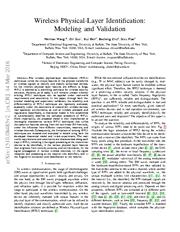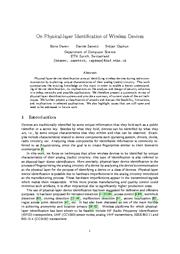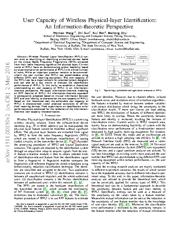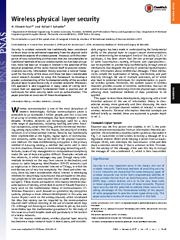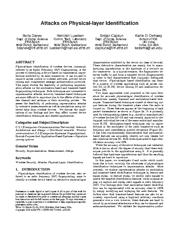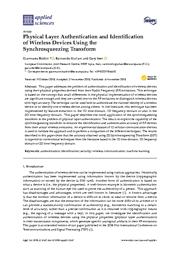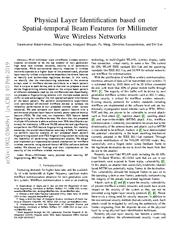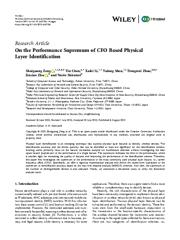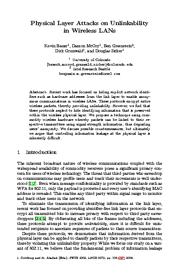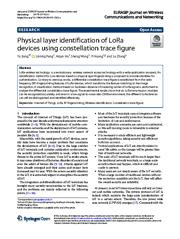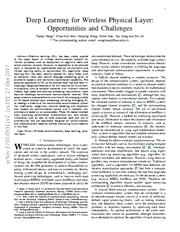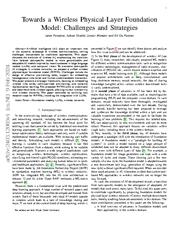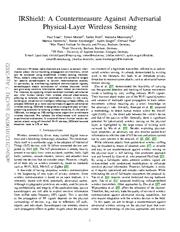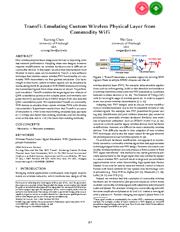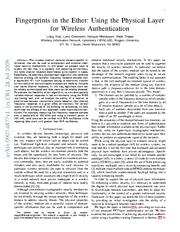A copy of this work was available on the public web and has been preserved in the Wayback Machine. The capture dates from 2020; you can also visit the original URL.
The file type is application/pdf.
Filters
Wireless Physical-Layer Identification: Modeling and Validation
[article]
2016
arXiv
pre-print
The wireless physical-layer identification (WPLI) techniques utilize the unique features of the physical waveforms of wireless signals to identify and classify authorized devices. ...
As the inherent physical layer features are difficult to forge, WPLI is deemed as a promising technique for wireless security solutions. ...
Such device identification solutions are defined as Wireless Physical-Layer Identification (WPLI) techniques [1] . ...
arXiv:1510.08485v2
fatcat:nhfddacuxrhjncjd3bmgw3u5me
On physical-layer identification of wireless devices
2012
ACM Computing Surveys
Physical-layer device identification aims at identifying wireless devices during radio communication by exploiting unique characteristics of their analog (radio) circuitry. ...
We therefore present a systematic review of physical-layer identification systems and provide a summary of current state-of-the-art techniques. ...
The authors validated their technique on 4 models, 10 devices per model. ...
doi:10.1145/2379776.2379782
fatcat:boyvan25o5fnznvwu5j2ng6uxy
User Capacity of Wireless Physical-layer Identification: An Information-theoretic Perspective
[article]
2016
arXiv
pre-print
Wireless Physical Layer Identification (WPLI) system aims at identifying or classifying authorized devices based on the unique Radio Frequency Fingerprints (RFFs) extracted from their radio frequency signals ...
at the physical layer. ...
Introduction Wireless Physical-layer Identification (WPLI) is a promising wireless security solution. ...
arXiv:1511.00150v2
fatcat:wxn57sw3p5b7hops7gyhfp2cye
Wireless physical layer security
2016
Proceedings of the National Academy of Sciences of the United States of America
wireless physical layer). ...
channel models of interest in modern wireless networks. ...
This work was supported in part by the US National Science Foundation under Grants CMMI-1435778 and ECCS-1647198 and in part by the German Research Foundation under Grant WY 151/2-1. ...
doi:10.1073/pnas.1618130114
pmid:28028211
pmcid:PMC5224364
fatcat:arb5vh24l5cjvpfgaeg3uedysy
Attacks on physical-layer identification
2010
Proceedings of the third ACM conference on Wireless network security - WiSec '10
Physical-layer identification of wireless devices, commonly referred to as Radio Frequency (RF) fingerprinting, is the process of identifying a device based on transmission imperfections exhibited by its ...
We discuss the implications of our findings and how they affect current device identification techniques and related applications. ...
Acknowledgments The authors thank Marc Kuhn and Armin Wittneben for their suggestions and assistance during the project. This work was partially supported by the Zurich Information Security Center. ...
doi:10.1145/1741866.1741882
dblp:conf/wisec/DanevLCD10
fatcat:7xnzgkqvsvazlmqe7cygh4v2ey
Physical Layer Authentication and Identification of Wireless Devices Using the Synchrosqueezing Transform
2018
Applied Sciences
This paper addresses the problem of authentication and identification of wireless devices using their physical properties derived from their Radio Frequency (RF) emissions. ...
This paper describes the novel application of the synchrosqueezing transform to the problem of physical layer authentication. ...
to the problem of physical layer authentication and identification. ...
doi:10.3390/app8112167
fatcat:6j3qnzvytnfinmlhhe36hcnzx4
Physical Layer Identification based on Spatial-temporal Beam Features for Millimeter Wave Wireless Networks
[article]
2019
arXiv
pre-print
While conventional security measures in wireless networks operate at a higher layer of the protocol stack, physical layer security utilizes unique device dependent hardware features to identify and authenticate ...
We also compare our beam pattern feature with a conventional physical layer feature namely power spectral density feature (PSD). ...
Such attacks could be mitigated by verifying the authenticity of the frames originating from the imposter devices at the physical layer by using physical layer identification techniques. ...
arXiv:1902.03649v1
fatcat:aaubriyeivazznhjlirjuimzfa
On the Performance Supremum of CFO Based Physical Layer Identification
2022
Wireless Communications and Mobile Computing
Physical layer identification is an emerging technique that exploits physical layer features to identify wireless devices. ...
The identification accuracy and the device quantity that can be identified at most are significant for the identification scheme. ...
Recently, the rich characteristics of the physical layer have been intensively investigated to implement device identification in wireless networks [4] [5] [6] , also known as physical layer identification ...
doi:10.1155/2022/3657706
fatcat:tiiagcyvh5dw7kne33qxklwn6u
Physical Layer Attacks on Unlinkability in Wireless LANs
[chapter]
2009
Lecture Notes in Computer Science
However, we find that these protocols neglect to hide identifying information that is preserved within the wireless physical layer. ...
We discuss possible countermeasures, but ultimately we argue that controlling information leakage at the physical layer is inherently difficult. ...
Acknowledgments We thank Jeffrey Pang and the anonymous reviewers for their insightful suggestions and comments, James Martin for granting access to our office building testbed, and Eric Anderson for assisting ...
doi:10.1007/978-3-642-03168-7_7
fatcat:ecqr4rpzibcaxkq7boz4hdorji
Physical layer identification of LoRa devices using constellation trace figure
2019
EURASIP Journal on Wireless Communications and Networking
An identification method for Lora devices based on physical layer fingerprinting is proposed to provide identities for authentication. ...
LoRa wireless technology is a revolutionary wireless network access technology with a wide application prospect. ...
[31] extracted the features for fingerprint recognition from the physical layer and data link layer of wireless local area network (WLAN) device. ...
doi:10.1186/s13638-019-1542-x
fatcat:hkijdkwuqjavfbohvrtydgnzvu
Deep Learning for Wireless Physical Layer: Opportunities and Challenges
[article]
2017
arXiv
pre-print
The potential application of DL to the physical layer has also been increasingly recognized because of the new features for future communications, such as complex scenarios with unknown channel models, ...
Machine learning (ML) has been widely applied to the upper layers of wireless communication systems for various purposes, such as deployment of cognitive radio and communication network. ...
Researchers have applied ML to the physical layer for modulation recognition [14] , [15] , channel modeling and identification [16] , [17] , encoding and decoding [18] , [19] , channel estimation ...
arXiv:1710.05312v2
fatcat:veeuomcadvcedghvy5om4rzgpm
Towards a Wireless Physical-Layer Foundation Model: Challenges and Strategies
[article]
2024
arXiv
pre-print
To overcome task-specific AI strategies in wireless networks, we propose a unified wireless physical-layer foundation model (WPFM). ...
models (LLMs) and computer vision. ...
the wireless domain to build a foundation model. • A wireless physical-layer foundation model (WPFM) framework. • Strategies to apply wireless use cases effectively. ...
arXiv:2403.12065v1
fatcat:qtecjtiemvbg3jbwfaghkjxvs4
IRShield: A Countermeasure Against Adversarial Physical-Layer Wireless Sensing
[article]
2022
arXiv
pre-print
IRShield is designed as a plug-and-play privacy-preserving extension to existing wireless networks. At the core of IRShield, we design an IRS configuration algorithm to obfuscate wireless channels. ...
We validate the effectiveness with extensive experimental evaluations. ...
This work was in part funded by the German Federal Ministry of Education and Research (BMBF) within the project MetaSEC (Grant 16KIS1234K) and by the Deutsche Forschungsgemeinschaft (DFG, German Research ...
arXiv:2112.01967v2
fatcat:zjxzzn6xfzdb7nuwzghvsuavmq
TransFi
2022
Proceedings of the 20th Annual International Conference on Mobile Systems, Applications and Services
New wireless physical-layer designs are the key to improving wireless network performance. ...
Adopting these new designs, however, requires modifications on wireless hardware and is difficult on commodity devices. ...
ACKNOWLEDGMENTS We thank our shepherd, Kate Ching-Ju Lin, and the anonymous reviewers for their comments and feedback. ...
doi:10.1145/3498361.3538946
fatcat:3537t5cuuba6hetnmjd7z3ylsy
Fingerprints in the Ether: Using the Physical Layer for Wireless Authentication
[article]
2009
arXiv
pre-print
Specifically, we describe a physical-layer algorithm that combines channel probing (M complex frequency response samples over a bandwidth W) with hypothesis testing to determine whether current and prior ...
The wireless medium contains domain-specific information that can be used to complement and enhance traditional security mechanisms. ...
While using the physical layer to enhance security might seem to be a radical paradigm shift for wireless systems, we note that this is not the first time that multipath and advanced physical layer methods ...
arXiv:0907.4877v1
fatcat:lyij5zhx4vao5h3jqntqzeobwe
« Previous
Showing results 1 — 15 out of 28,101 results

